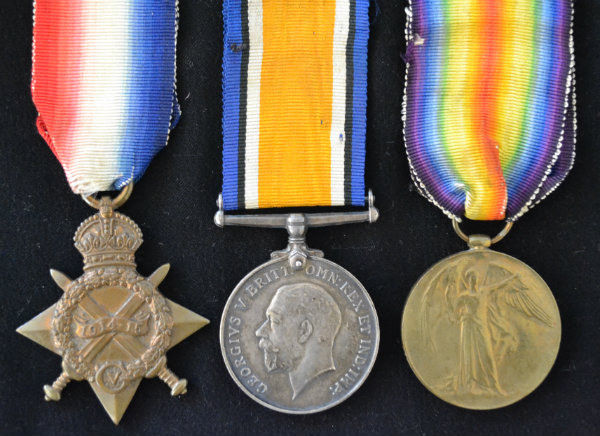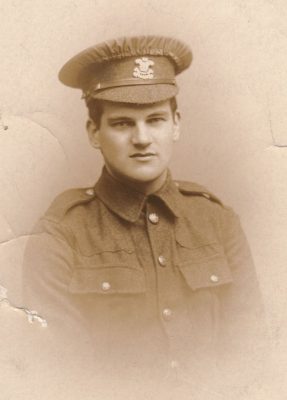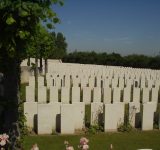Personal Details
Albert Jeffrey Cartwright (known as Bertie), born in Bronington, Flintshire, Wales on 29 October 1890, the first son of Esther Humphreys (his birth certificate indicates no father’s name). The 1891 and 1901 Censuses show Albert as the son of Elias and Ann Cartwright of Hanmer Road, Tybroughton, Flintshire, Wales. We can only assume that the Cartwright’s ‘adopted’ Albert who assumed their name at some point after 1901. The first adoption laws were introduced into the UK in 1926.
Husband to Priscilla Cartwright (nee Hopkin) (married 24 April 1915) of 189 Bridgend Road, Aberkenfig, Bridgend, Glamorgan, Wales.
Military Details
Regiment : 2nd Battalion Welsh Regiment
Rank : Private
Service Number : 1567
Died from wounds; France 26 September 1915 Aged 24

The 1914 Star (also known as 'Pip') was authorised under Special Army Order no. 350 in November 1917 and by an Admiralty Fleet Order in 1918, for award to officers and men of the British and Indian Expeditionary Forces who served in France or Belgium between 5 August and midnight of 22–23 November 1914. The former date is the day after Britain's declaration of war against the Central Powers, and the closing date marks the end of the First Battle of Ypres.
The 1914–15 Star (also known as 'Pip') was instituted in December 1918 and was awarded to officers and men of British and Imperial forces who served against the Central European Powers in any theatre of the Great War between 5 August 1914 and 31 December 1915. The period of eligibility was prior to the introduction of the Military Service Act 1916, which instituted conscription in Britain.
The British War Medal (also known as 'Squeak') was a silver or bronze medal awarded to officers and men of the British and Imperial Forces who either entered a theatre of war or entered service overseas between 5th August 1914 and 11th November 1918 inclusive. This was later extended to services in Russia, Siberia and some other areas in 1919 and 1920. Approximately 6.5 million British War Medals were issued. Approximately 6.4 million of these were the silver versions of this medal. Around 110,000 of a bronze version were issued mainly to Chinese, Maltese and Indian Labour Corps. The front (obv or obverse) of the medal depicts the head of George V. The recipient's service number, rank, name and unit was impressed on the rim.
The Allied Victory Medal (also known as 'Wilfred') was issued by each of the allies. It was decided that each of the allies should each issue their own bronze victory medal with a similar design, similar equivalent wording and identical ribbon. The British medal was designed by W. McMillan. The front depicts a winged classical figure representing victory. Approximately 5.7 million victory medals were issued. Interestingly, eligibility for this medal was more restrictive and not everyone who received the British War Medal ('Squeak') also received the Victory Medal ('Wilfred'). However, in general, all recipients of 'Wilfred' also received 'Squeak' and all recipients of The 1914 Star or The 1914/1915 Star (also known as 'Pip') also received both 'Squeak' and 'Wilfred'. The recipient's service number, rank, name and unit was impressed on the rim.
Further Information
Report in the Glamorgan Gazette 29 October 1915 regarding the death of Albert Jeffrey Cartwright
"Private Albert Cartwright (1567), 2nd Battalion, Welsh Regiment, B.E.F., France, was one of the British heroes who died on the battlefield, fighting for his King and country. He was a young man of 24 years of age, and was well known at Angelton, where he had been an attendant for about two years. From there he went to Ogmore Vale, where he worked for about eighteen months. He enlisted in August, 1914, and went out to France in November of the same year. On January 28th this year he was wounded, in action at La Basse, France. On February 1st he was transferred to the Metropolitan Hospital, London, and remained there until March. Then he went home to recuperate at Whitchurch, Salop. On April 24th, 1915, he was married to Miss Priscilla Hopkin, 189 Bridgend Road, Aberkenfig, at Penyfai Church. A few days after his marriage he was again drafted out to France, and on September 26th he was seriously wounded, and died on September 27th. A letter was received from the chaplain of West Riding Casualty Clearing Station stating that Priv. Cartwright bore his wounds with the greatest patience, and "died as bravely as he fought." He was the son of Mr. Elias Cartwright, Ty Broughton Farm, Whitchurch, Salop. Young Mrs. Cartwright, being well known at Aberkenfig, has the sympathy of a large number of friends in her great loss."
Glamorgan Gazette 29 October 1915
More information about Albert Jeffrey Cartwright is available from Flintshire War Memorials.
If you can provide any further information on Albert Jeffrey Cartwright please get in touch by leaving a comment below, using our Contact Form or by calling in to Whitchurch Heritage Centre.
Information provided by Whitchurch Museum and Archives



Albert is my great great Uncle and I have research he’d his story which I am happy to share. He has an unusual memorial in a bus shelter.
Hi Claire
We would be very interested in your research. Is he the chap commemorated at Eglwys Cross ? One of our Volunteers, Simon Birch, was involved in the memorial.
Look forward to hearing from you
Regards
Judith
(volunteer curator)